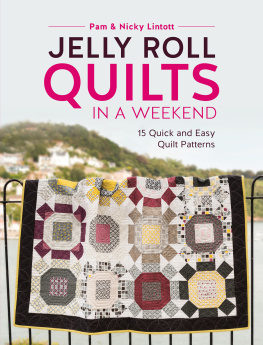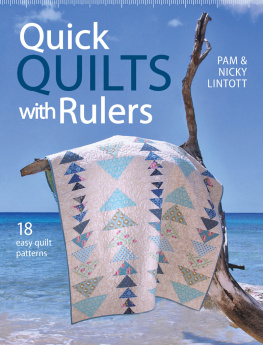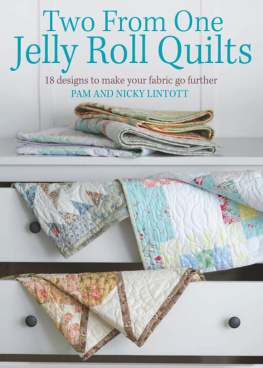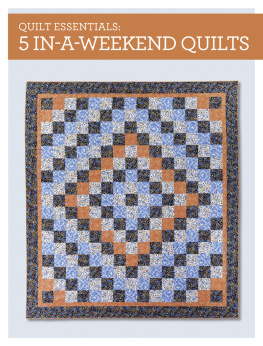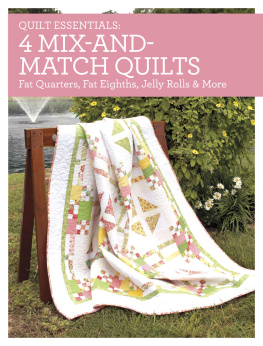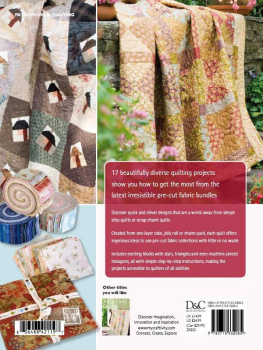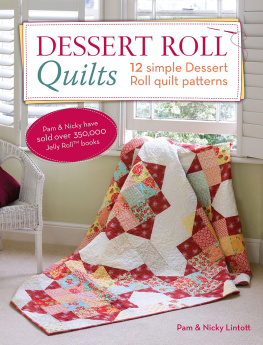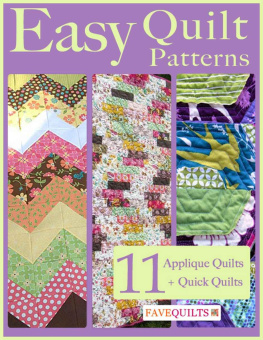Contents
Guide
Pam & Nicky Lintott
JELLY ROLL
QUILTS
IN A WEEKEND
15 Quick and Easy Quilt Patterns

www.sewandso.co.uk
Contents
Introduction
There is so much you can do with a jelly roll that we never tire of them forty strips of fabric wound up into such a delicious looking roll... gorgeous! It really is true that the most difficult thing about a jelly roll is unravelling it! Once youve done that, then you have before you forty different fabrics which will be the basis of your quilt. The colours all coordinate and you just have to decide on your quilt pattern. The quilts in this book use just one jelly roll. You may need some background fabric and possibly a border fabric for some quilts, but essentially your quilt top is made up of those forty fabrics. How amazing is that?
So, armed with your jelly roll, you just have to flick through the pages of this book to decide which quilt you are going to make this weekend. We have carefully selected designs that are quick and easy to put together and hopefully look far more complicated than they really are. We have timed the piecing of the quilts and each of them can be pieced in a weekend, and then all you have to do is the quilting and finishing off. Towards the end of the book we have designed a couple of quilts that may take a long weekend, but essentially over the space of a couple of days you can make any of these quilt tops. Sounds too good to be true? Just have a try!
We have placed the quilts in the book roughly in the time taken to make them, from the shortest to the longest. This is approximate and obviously there are going to be occasions when something takes a little longer than expected. However, none of the designs are difficult so just pick a quilt and off you go. Better still, meet up with a friend and have fun making two quilts!
Pam and Nicky

Getting Started
WHAT IS A JELLY ROLL?
Moda introduced jelly rolls to showcase new fabric ranges and a jelly roll is a roll of forty fabrics cut in 212in wide strips across the width of the fabric. How inspirational to have one 212in wide strip of each new fabric wrapped up so deliciously! Our thanks go to Moda for inspiring us and allowing us to use the name jelly roll in this book. All the quilt patterns here assume that fabric will be at least 42in wide. If you want to make any of the quilts in the book and dont have a jelly roll to use, then cut a 212in wide strip from forty fabrics in your stash and you can follow all the instructions in just the same way to make a quilt.
IMPERIAL OR METRIC?
Jelly rolls from Moda are cut 212in wide and at The Quilt Room we have continued to cut our strip bundles 212in wide. When quilt making, it is impossible to mix metric and imperial measurements. It would be absurd to have a 212in strip and tell you to cut it 6cm to make a square! It wouldnt be square and nothing would fit. This caused a dilemma when writing instructions for our quilts and a decision had to be made. All our instructions therefore are written in inches. To convert inches to centimetres, multiply the inch measurement by 2.54. For your convenience, any additional fabric you need is given in the You Will Need panel at the start of the quilt instructions, in both metric and imperial.
SEAM ALLOWANCE
We cannot stress enough the importance of maintaining an accurate scant 14in seam allowance throughout. Please take the time to check your seam allowance with the test described in the General Techniques section.
QUILT SIZE
In this book we have shown what can be achieved with just one jelly roll (forty 212in strips). We have sometimes added background fabric and borders but the basis of each quilt is just one jelly roll.
DIAGRAMS
Diagrams have been provided to assist you in making the quilts and these are normally beneath or beside the relevant stepped instruction. The direction in which fabric should be pressed is indicated by small arrows on the diagrams. The reverse side of the fabric is usually shown in a lighter colour than the right side.
WASHING NOTES
It is important that pre-cut strips are not washed before use. Save the washing until your quilt is complete and then make use of a colour catcher in the wash, or possibly dry clean the quilt.
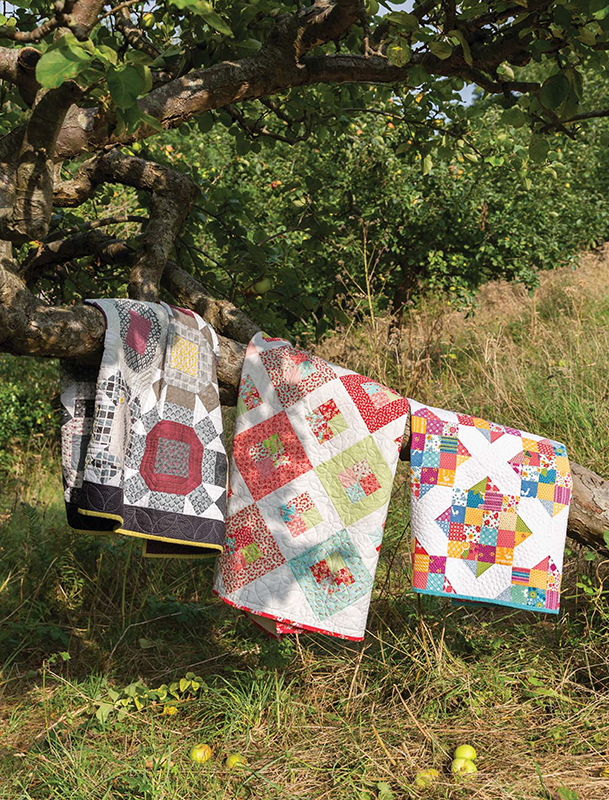
BOARDWALK
This quilt is a delight to make and is so easy it just about makes itself. Its a perfect weekend project, and proof that designs do not have to be time-consuming and complicated to look great. We used a roll-up from Robert Kaufman, designed by Karen Lewis, called Blueberry Park. When giving yardage requirements for the sashing, we allowed a little extra so these strips can be cut lengthways. It only uses a small amount of extra fabric and we felt it was better not to have joins in the sashing and border strips. We generally avoid wastage but in this instance we felt it was justified.
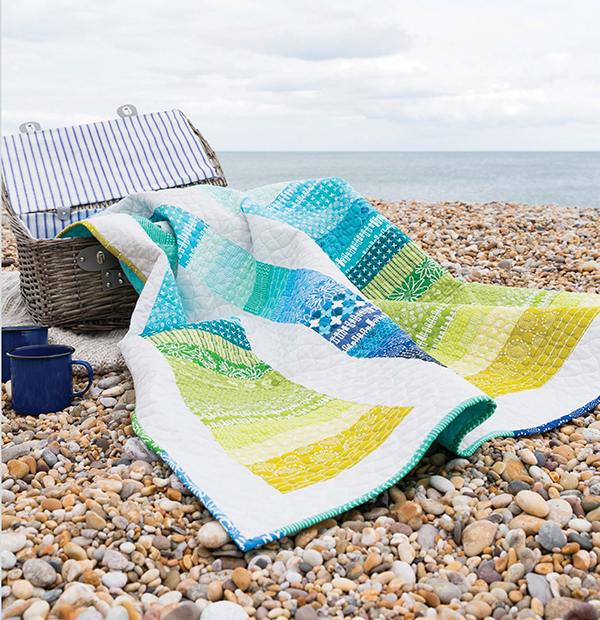
VITAL STATISTICS
Finished size: 54in x 73in
YOU WILL NEED
- One jelly roll (or forty 212in x width of fabric strips from your stash)
- 2yds (1.8m) of fabric for sashing and border
- The scrappy binding is made from left-over jelly roll strips
PREPARATION AND CUTTING
SORTING THE JELLY ROLL STRIPS
Sorting the colours is the most important part of this quilt as you want your colours to blend into each other and shade from dark to light. Choose thirty-three strips and sort them according to how you want them to be sewn together. Put the remaining seven strips aside for the scrappy binding.
CUTTING THE SASHING AND BORDER FABRIC
Cut six 4in wide strips lengthways down the fabric. The remainder of the fabric is spare.
MAKING THE QUILT
STRIP PIECING
Working from dark to light, sew five jelly roll strips together down the long sides to form a strip unit, as shown in the diagram. Sew one strip in place, sewing in one direction, and add the next strip by sewing in the opposite direction, and so on. This will prevent the strip unit bowing. Press towards the darker fabric.

Keeping your strips in your chosen order, repeat this process with all thirty-three jelly roll strips to make a total of seven strip units. Each strip unit should be 1012in deep at this stage. Note: The last strip unit will only have three strips and will measure 612in.
Take each strip unit, trim off the selvedges and cut the unit into one 412in segment, one 812in segment and one 2812in segment.


